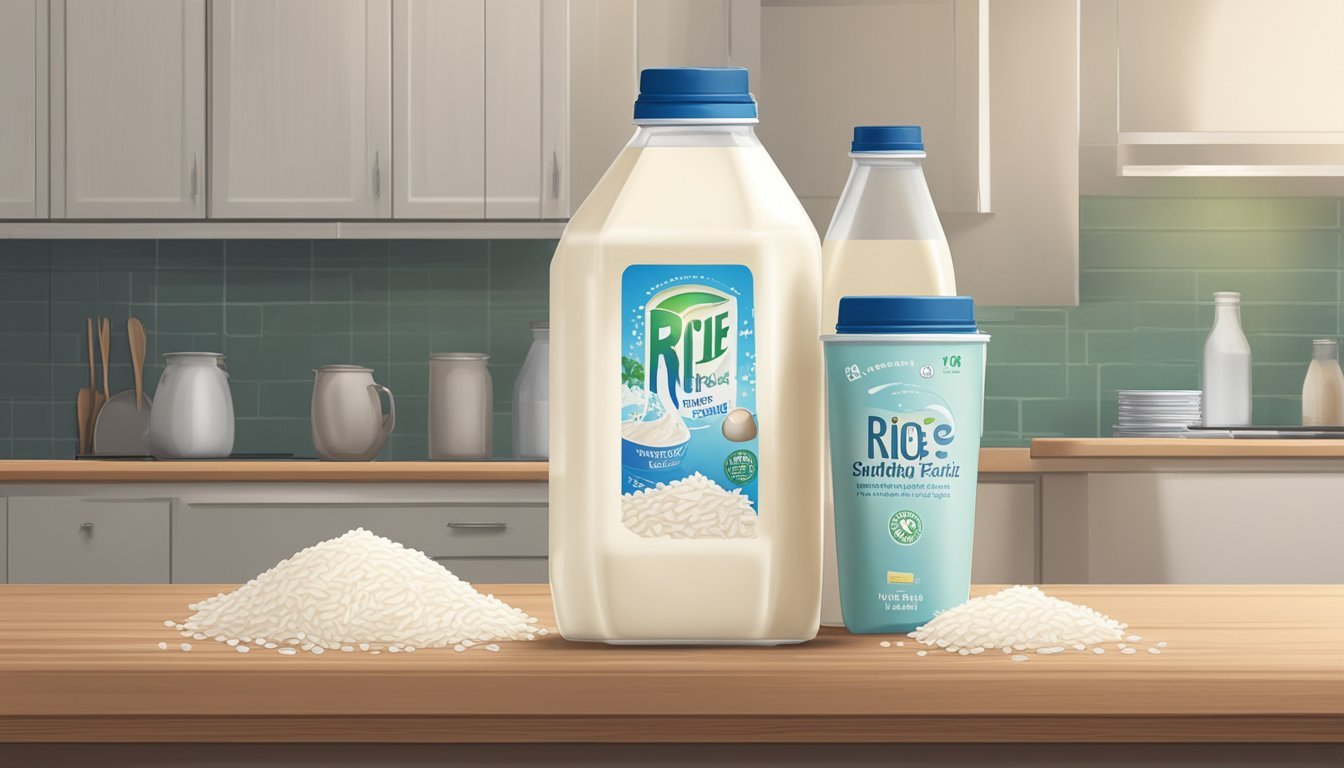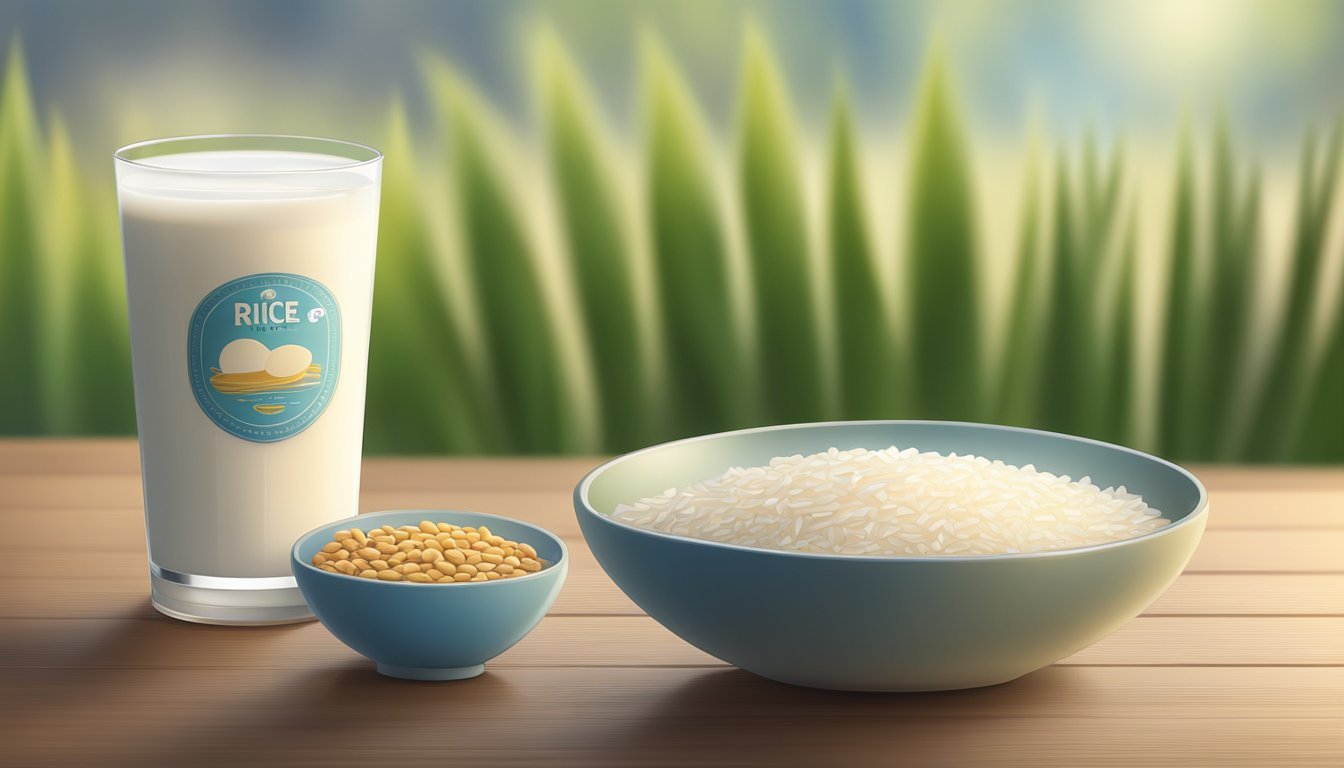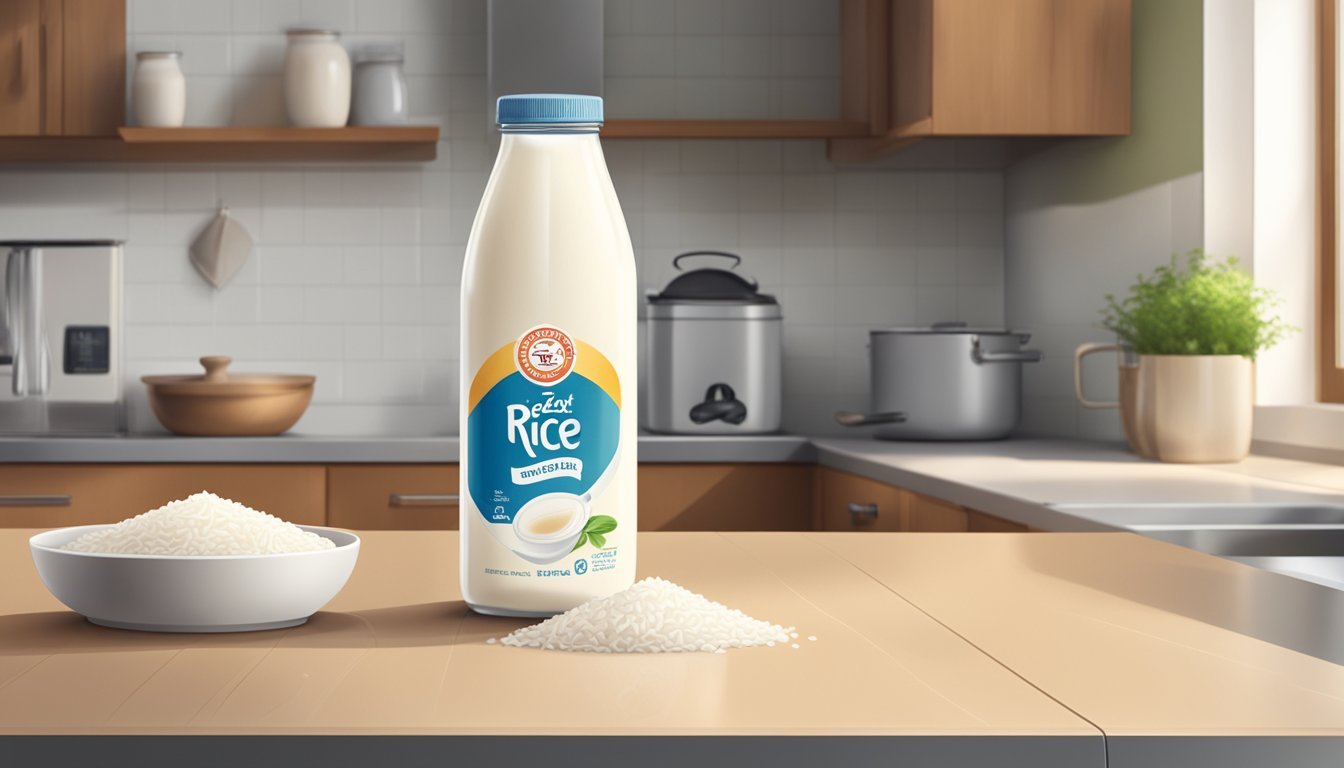How Long Does Rice Milk Last?
Shelf Life and Storage Tips
Rice milk is a popular dairy-free alternative to traditional cow's milk, enjoyed by vegans and those with dietary restrictions alike for its mild taste and versatility. As a plant-based milk, it serves not only as a beverage but also finds use in various culinary applications. Typically, unopened rice milk, when stored properly in a cool and dry location, maintains its quality for months until the expiration date printed on the packaging.
Once opened, rice milk's shelf life decreases significantly. It is generally advised to consume it within 7 to 10 days. For the best experience in both flavor and safety, it should be refrigerated continuously, as its quality can degrade quickly at room temperature. Ensuring that rice milk is kept away from sources of heat and light can also help maintain its freshness for as long as possible.
It's important to observe changes in color, smell, or consistency, as these can indicate spoilage. A shift from its naturally creamy texture to a clumpy or thicker consistency is a clear sign the rice milk is no longer suitable for consumption. Consumers should rely on both the provided use-by dates and their own judgment when assessing the freshness of their rice milk.
Understanding Rice Milk
Rice milk is a popular non-dairy milk alternative known for its naturally sweet flavor and hypoallergenic properties. This plant-based milk is a suitable option for those with dietary restrictions, including lactose intolerance, and those seeking a gluten-free option.
Nutritional Profile
Rice milk typically contains a blend of milled rice and water, which results in a drink lower in protein and fat compared to dairy milk. However, it provides a reasonable amount of carbohydrates and calories. Manufacturers often fortify rice milk with nutrients to enhance its nutritional value. A standard cup of commercial rice milk may include the following approximate values:
Calories: 120-130
Protein: 1g
Fat: 2g (usually without saturated fat)
Carbohydrates: 24-26g
Calcium: Often fortified to be comparable to cow's milk
It is important to note that the homemade version may not contain added nutrients unless they are included intentionally during preparation.
Comparing with Other Plant Milks
When compared to other plant-based milks like almond, soy, or oat milk, rice milk stands out for its naturally sweet taste and minimal allergenic risk. Here's a brief comparison of their nutritional profiles:
Nutrient Rice Milk Almond Milk Soy Milk (how long does soy milk last?) Oat Milk Protein Low (1g) Low (1g) High (7g) Moderate (3g) Fat Low (2g) Low (2.5g) Moderate (4g) High (5g) Carbohydrates High (24-26g) Low (1g) Low (3g) High (24g) Calories 120-130 30-50 80-100 120-140
Rice milk, missing significant protein and saturated fat, has a higher carbohydrate content. On the other hand, soy milk offers more protein, making it a closer alternative to dairy in terms of nutritional content. Almond milk, while lower in calories and carbohydrates, may not meet energy needs without other dietary sources. Oat milk provides more calories and carbohydrates, resembling the energy content of rice milk but offering more protein. Each milk has its advantages, and the choice often depends on dietary preferences, nutritional needs, and potential allergies.
Shelf Life Basics
The shelf life of rice milk is influenced by a variety of factors including whether it is opened or unopened, the presence of preservatives, and if it is shelf-stable. Understanding these can help ensure the quality and safety of the rice milk consumed.
Unopened Rice Milk
Unopened rice milk, particularly the shelf-stable variety, can be stored safely until the expiration date printed on the package. This type of rice milk is designed to remain fresh while stored at room temperature due to aseptic packaging and the use of preservatives. Typically, shelf-stable rice milk has an extended shelf life that can range from several months to a year, depending on the brand and storage conditions.
Opened Rice Milk
Once opened, rice milk's shelf life reduces considerably. It should be refrigerated immediately after opening to maintain quality. Opened rice milk generally lasts for 7-10 days when stored properly in the fridge. The key is to keep it tightly sealed in its original container or a suitable airtight container to minimize exposure to air and potential contaminants. Freezing opened rice milk can extend its usability for an additional 3-6 months, although changes in texture and taste may occur after thawing.
Storage Techniques
Proper storage of rice milk is essential for preserving its freshness and extending its shelf life. Below are guidelines for refrigerating and freezing rice milk correctly, ensuring quality and safety.
Refrigeration Guidelines
Once opened, rice milk should be kept refrigerated at temperatures between 35°F and 40°F. It is advisable to store it in its original package to minimize exposure to air and potential contaminants. If the original package is not resealable, one should transfer the rice milk into an air-tight container. Rice milk should not be stored in the fridge door, as the temperature there fluctuates more than in the main compartment. An opened container of rice milk will generally remain fresh for about 7 to 10 days when stored properly in the refrigerator.
Freezing Methods
For longer storage, rice milk can be frozen for up to 3 to 6 months. Freezing should be done in an air-tight container or a freezer-safe bag to prevent freezer burn and odor absorption from other foods. It's important to leave some space at the top of the container because rice milk expands when frozen. Thawing should be done in the refrigerator, and once thawed, the rice milk should be consumed within a few days. It should not be refrozen after thawing. Note that freezing may cause a slight separation or change in texture, but this does not affect the milk's safety or nutritional value.
Identifying Spoilage
The shelf life of rice milk can vary, and knowing the signs of spoilage is essential for safe consumption. A close examination of its visual appearance, texture, odor, and flavor will determine if rice milk has gone bad.
Visual and Texture Changes
One should inspect rice milk for any visual signs of spoilage, which include:
Color: Fresh rice milk has a consistent color. If one notices any discoloration or dark spots, the product may be spoiling.
Consistency: A uniform consistency is typical for rice milk. The presence of clumps, thickening, or separation of layers signals spoilage.
Package: A bloated package can indicate bacterial activity and gas build-up, suggesting that the rice milk has spoiled.
Odor and Flavor Assessment
To assess whether rice milk has spoiled:
Smell: Rice milk should have a mild, sweet scent. A sour or unusual odor is often an indicator of spoilage.
Taste: Although tasting is not recommended for safety reasons, spoiled rice milk typically has a sour or off flavor.
If mold is visible or the aforementioned attributes are present, one should dispose of the rice milk to avoid potential health risks.
Rice Milk in Culinary Uses
Rice milk has found its niche in the culinary world as a versatile alternative for those with dietary restrictions and as a subtle, creamy addition to various recipes. It imparts a lightly sweet flavor, making it suitable for both sweet and savory applications.
Recipes and Cooking
For Cooking: Rice milk can easily substitute for cow's milk in most recipes due to its similar consistency. Chefs may include it in sauces, baking, and even dressings to add a mild sweetness and smooth texture without overpowering other flavors. Due to its plant-based origin, rice milk is ideal for vegan recipes.
Sauces and Soups: Rice milk can create a creamier consistency in dishes like soups and sauces that require a milk-based liquid.
Baking: It is often used in cakes, cookies, and bread where milk is needed, contributing to a tender crumb.
Beverage Applications
For Beverages: The character of rice milk as a beverage is notable for its naturally sweet taste, attributed to the carbohydrates from brown rice. It shines in applications such as coffee and tea where a smooth, dairy-free milk alternative is needed.
Coffee and Tea: Perfect for those who prefer a plant-based creamer with a less assertive flavor.
Smoothies: It blends seamlessly with fruits and other ingredients to create lighter, yet creamy smoothies.
Allergy-Friendly Alternatives
For Allergies: Rice milk is an excellent choice for individuals with allergies or intolerances as it avoids common allergens found in dairy or other plant-based milks like soy and almond.
Lactose Intolerant: It serves as a safe option for those who cannot digest lactose.
Food Allergies: Rice milk reduces the risk of triggering food allergies, especially for those sensitive to nuts or soy.
By integrating rice milk into a variety of dishes and drinks, culinary enthusiasts and professionals can cater to a broader audience, including those seeking lactose-free, allergy-friendly, or plant-based ingredients, without sacrificing taste or texture.
Making Homemade Rice Milk
Homemade rice milk offers a quality and taste that can be a delightful alternative or complement to other plant-based milks. One can prepare it with minimal equipment and ingredients straight from the kitchen.
DIY Preparation
To make homemade rice milk, one begins by soaking white rice in hot water for about two hours; this softens the grains without cooking them. Draining the rice and blending it with fresh water at a high speed results in a milky liquid. Straining the mixture through a nut milk bag ensures a smooth, drinkable consistency. This simple process yields a fresh, preservative-free rice milk that exhibits a subtle, natural flavor. The use of cooked rice is also an option for creating a creamier milk.
Ingredients
White rice
Hot water
Nut milk bag (for straining)
Steps
Soak white rice in hot water.
Blend with fresh water.
Strain through a nut milk bag.
Comparison to Store-Bought
Homemade rice milk typically lacks the additives and preservatives found in store-bought varieties, which can affect both quality and taste. While store-bought rice milk often includes vitamins and minerals for enhanced nutrition, homemade milk has a straightforward ingredient list. Store-bought options come in shelf-stable or refrigerated forms and contain emulsifiers or thickeners to maintain consistency and extend shelf life. In contrast, homemade rice milk has a shorter shelf life and may separate upon sitting, which is remedied by a simple shake or stir before use.
Homemade vs. Store-Bought Rice Milk
Aspect Homemade Rice Milk Store-Bought Rice Milk Ingredients Few; mainly rice and water May include additives Shelf Life Up to 5 days in the fridge Longer due to preservatives Consistency May separate; stir before use Usually homogenized Nutritional Additives None Often fortified with vitamins
By understanding these differences, consumers can make an informed choice between the homemade version and commercial offerings based on their preferences for taste, quality, and convenience.
Safety and Health Considerations
When considering the safety and health implications of rice milk consumption, it is paramount to consider both the nutritional benefits provided by this plant milk and the risks that improper storage practices could pose. Rice milk, a popular dairy alternative, offers certain dietary advantages, but like all foods, maintaining its quality and safety is essential.
Nutritionist Insights
Registered dietitians emphasize that rice milk is naturally low in cholesterol and fat, making it a favorable choice for individuals managing their fat intake. They also point out that rice milk can be fortified with vitamins and minerals, such as vitamin D and calcium, to match the nutrition profile of dairy milk. However, rice milk tends to be lower in protein when compared to cow's milk, which should be accounted for in one's diet.
Risks and Warnings
The safety of rice milk is largely dependent on appropriate storage practices. Unopened rice milk can be stored in cool, dry conditions away from light and heat. Once opened, rice milk must be refrigerated and ideally consumed within 7 to 10 days to minimize the danger of bacterial growth. Any signs of spoilage, such as an off odor or flavor, are clear indicators that the rice milk should be discarded to avoid health risks. Moreover, consumers should be cautious with rice milk labeled as non-refrigerated or shelf-stable; these varieties should be refrigerated after opening and adhered to the same scrutiny for signs of spoilage.
Packaging and Labeling Tips
When selecting rice milk, consumers should pay close attention to the packaging and labeling as they are crucial for determining the freshness and shelf life of the product.
Understanding Labels
Rice milk containers come with labels that provide essential information on expiration dates and storage requirements. The expiration date is typically set about a year from the production date and is critical for consumers to assess the freshness of the product. However, rice milk can often maintain its quality for a few months beyond this date if stored properly.
Production Date: Usually about a year before the expiration date.
Expiration Date: Key indicator to assess freshness.
Labels should be read carefully to understand how long the rice milk will last after purchase. Unopened rice milk requires proper storage conditions to preserve its quality, and the label often includes instructions on whether the product needs to be refrigerated or can be stored at room temperature in a cool, dry place to prevent spoilage.
Importance of Packaging
The packaging of rice milk is not just about aesthetics; it serves to protect the product from external contaminants and can affect the product's shelf life. Rice milk is typically sold in cartons or plastic containers, which should be sealed properly to ensure sterilization and prevent bacterial growth.
Type of Container: Cartons or plastic containers.
Storage Condition:
Refrigerated: Always keep at a temperature below 40°F (4°C).
Unopened: Store in a cool, dry, and dark place, away from direct sunlight.
Properly-packaged rice milk, which includes tamper-proof seals, can last for about 7-10 days once opened, and special attention should be paid to the integrity of the packaging when purchasing. Any sign of damage or tampering might compromise the quality and safety of the content. The consumer should ensure that the rice milk is stored correctly according to the packaging instructions to maintain its freshness and nutritional value for as long as possible.
Frequently Asked Questions
In this section, readers will find authoritative answers to common queries surrounding the use and preservation of rice milk.
FAQs on Rice Milk Usage
Q: Can rice milk be heated in the microwave?
A: Yes, one can heat rice milk in the microwave, but it's advised to do so cautiously and in short intervals to avoid curdling, stirring periodically for even warmth.
Q: How can one recognize that rice milk is no longer fresh?
A: Indicators of rice milk past its freshness include changes in color, texture, or smell. Originally opaque white or beige, any discoloration can be a sign of spoilage.
FAQs on Storing and Shelf Life
Q: What is the recommended method for storing rice milk to maintain freshness?
A: To retain freshness, store rice milk in the refrigerator consistently at or below 40°F (4°C), both before and after opening.
Q: How long does rice milk last once opened?
A: Once opened, rice milk generally lasts for about 7 to 10 days, provided it is refrigerated immediately after use.
Condition Shelf Life Unopened Carton Up to date on label plus some margin Opened and Refrigerated Approximately 7-10 days
Additional Considerations and Tips
In considering how long rice milk lasts, one must also evaluate the impact of nutritional additives and compare its shelf life to that of dairy milk. Both factors can influence the consumer's choice and usage.
Vitamins and Supplemental Additions
Rice milk is often fortified with vitamins and minerals to match the nutritional profile of dairy milk. It is especially important to check for vitamin A and vitamin D fortification, which are common in dairy-free milk alternatives.
Vitamin A: Essential for immune function and vision.
Additives: Some brands may include added sugar, so consumers seeking a low-sugar option should read labels carefully.
Comparison with Dairy Milk
When choosing between rice milk and dairy milk, consumers should consider their dietary needs. Rice milk is a popular vegan and dairy-free milk alternative and typically has a longer shelf life than dairy milk when unopened.
Shelf Life Comparison: Dairy milk usually lasts up to 7-10 days after opening, whereas rice milk can last the same amount under proper refrigeration. However, unopened shelf-stable rice milk can last significantly longer than dairy milk.
Vegan Considerations: For those following a vegan diet, rice milk offers a plant-based alternative that avoids the use of animal products.








